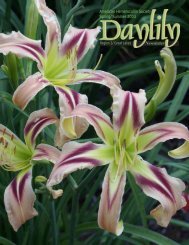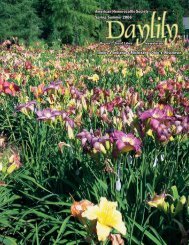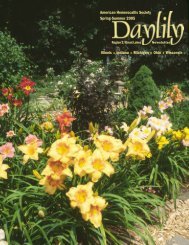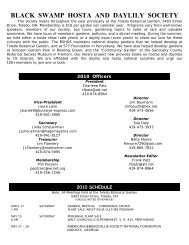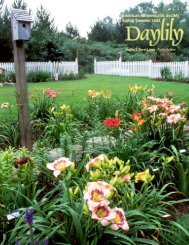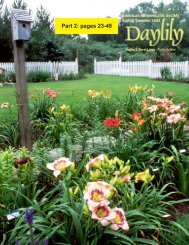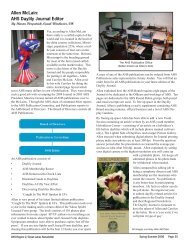Pages - AHS Region 2
Pages - AHS Region 2
Pages - AHS Region 2
You also want an ePaper? Increase the reach of your titles
YUMPU automatically turns print PDFs into web optimized ePapers that Google loves.
first frost. A third variety that attracted me was Panicum virgatum<br />
‘Shenandoah’. This switch grass had reddish ends and in October<br />
will turn into a symphony of red and orange colors. Hiding behind<br />
this grass was an owl placed there by Jack to keep out the undesirables.<br />
As I headed back up the path to exit the “Magic Garden,” I<br />
noticed the glider perched about ten feet away from and overlooking<br />
the “Magic Garden.” What a perfect spot for Jack or Carrie to<br />
rest and observe the fruits of their labors. On each side of the<br />
glider was situated a plant pot housing a Mandevilla Vine growing<br />
up a trellis and stretching across the top of the glider. Big, beautiful,<br />
pink flowers dotted the growing vines. In a week or so the two<br />
vines will meet at the center. A dreamer might suggest that the two<br />
vines were like lovers’ hands reaching out to clasp one-another. A<br />
cynic would observe that when cold weather sets in this fall the<br />
plants will have to be cut back and moved into the safety of the<br />
house. (I prefer the first observation!). Near the swing-set is a bed<br />
of Crocosmia. The foliage is iris-like; the flowers are bright reddish-orange<br />
and light up the whole area. I believe that this South<br />
African beauty is not hardy. While it lasts, it is an eyeful!<br />
One might not expect it; however, the zoning laws in Cincinnati<br />
allow for the presence of a small condominium in the<br />
Brueggemanns’ back yard. In this case this structure was<br />
designed and built by Carrie and consists of dozens of bird<br />
houses hanging from the branches of a Star Magnolia tree. After<br />
the tree provides its showy profusion of flowers in the spring,<br />
the tree becomes the home of dozens of birds who do not seem<br />
to mind the busy “condo” life-style.<br />
Also in the back yard is another American sweet gum tree.<br />
These trees are really interesting to me because they do not grow<br />
in Madison, Wisconsin, (Zone 4). The leaves look kind of<br />
“maple-like” and Jack says that his ‘Burgundy’ variety turns a<br />
beautiful red-burgundy color when the cool, crisp nights of fall<br />
come to Cincinnati. My feet discovered another feature of this<br />
tree—the seed pods are woody, spiny-balled structures. These<br />
rascals do not provide a great environment for grandchildren to<br />
run around barefoot!<br />
My ears attracted me to the last big attraction at Tranquility<br />
Garden. I could hear the sound of running water and remembered<br />
the shady, fenced in area adjacent to the house. This area<br />
contains a waterway leading to a shady pond replete with water<br />
plants including papyrus and dark green lily pads and is inhabited<br />
by bright colored koi. All kinds of shade-loving plants are<br />
situated here along with a patio area with comfortable furniture<br />
and a portable grill. This spot, just outside the back door, must<br />
provide the perfect shady spot for company (and Jack & Carrie)<br />
to relax. At this point my pals and I thanked Jack for his hospitality<br />
and headed back to Madison. It was great fun having a<br />
leisurely visit at Tranquility Gardens.<br />
NEW LONDON KNOLL<br />
Betsy Detmer<br />
1562 New London Road, Hamilton, Ohio.<br />
By Julie Gridley, Chardon, Ohio.<br />
New London Knoll is the 3 ½ acre estate of Betsy Detmer and is the<br />
place she has called home for 37 years. Its name was taken from the<br />
road in front, New London, and the word “knoll” seemed appropriate<br />
for the rise of land on which the house sits. From there, the<br />
sweeping front yard slopes down to a large pond and a bed of<br />
daylilies which are the first taste of what awaits in back.<br />
Betsy has been gardening for as long as she can remember, as<br />
her parents were both avid gardeners. The homestead of her childhood<br />
was mostly a shady one, however, and she now marvels at<br />
the fact that her parents were growing extensive shade gardens at<br />
a time when hostas were not readily available. As she moved on<br />
and started developing her own gardens, Betsy came across a bed<br />
of tall, white irises which had a daylily plant in the middle. She<br />
moved that plant to its own spot and started to pay closer attention<br />
to other daylilies she saw. When she offered to help clear out some<br />
beds of a local man, Mr. Krekler, who hybridized both peonies and<br />
daylilies, she came home with some new plants that fueled her<br />
interest. She was soon introduced to the Top ‘O the Hill nursery,<br />
where all daylilies cost just $5 a clump at the time. The day she<br />
visited a different grower and paid $30 for H. ‘Siloam Double Classic’,<br />
she declared that she had all the daylilies she could ever want.<br />
That was several years and many, many daylilies ago, needless to<br />
say!<br />
Right: H. ‘Adopt Me”.<br />
Image: Julie Gridley<br />
Below: This seedling daylily<br />
by J.R. Blanton drew many<br />
comments in more than one<br />
of the tour gardens. Its<br />
garden name is “Little Red<br />
Squirrel.”<br />
Image: Heidi Willet<br />
Betsy’s garden includes a<br />
wonderful mix of old and new<br />
daylilies, but she has developed<br />
a special fondness for<br />
pinks and doubles. She has<br />
come to appreciate and seek<br />
out plants that have good<br />
vigor and health in her area<br />
and in the clay soil native to<br />
the region. In this search<br />
for healthy plants, Betsy has<br />
learned that Bryant Millikan<br />
bred many daylilies that do<br />
well in her area, as did the<br />
woman whose work built on<br />
his program, Marge Soules.<br />
Betsy amends her clay with<br />
compost, but her philosophy<br />
in general is that plants which<br />
earn a place in her garden need to be tough enough to thrive in clay.<br />
Moles present a challenge, too, as they tend to turn under any<br />
mulch that is used by their tunneling.<br />
Betsy considers herself a general gardener who happens to specialize<br />
in daylilies. She aspires to have a garden with year-round<br />
interest, so she plants self-seeding annuals like poppies, larkspur,<br />
and cleome for summer bloom, and in the spring her beds are filled<br />
with daffodils. She also has a nice collection of epimediums and<br />
hostas that stay cool under her trees. And, speaking of trees, at<br />
one corner of her yard is a huge ornamental pear tree that impressed<br />
all who saw it. Betsy planted it 34 years ago and attributes its long<br />
life to the fact that it is an older variety which doesn’t share the<br />
weakness of the newer hybrids. Even our more expert tree lovers<br />
were astonished by the size of this specimen.<br />
Betsy had prepared a large bed for guest plants and hosted<br />
many from Brookwood Gardens. During our visit, “Mr. Brookwood”<br />
himself, Leo Sharp, held court near the display of his beauties and<br />
enjoyed them with the rest of us. Looking especially striking at the<br />
time was ‘Brookwood Amenable’, a glowing gold blend with lots of<br />
substance and ruffling. We also enjoyed the more subtle and feminine<br />
‘Brookwood Dorothy Schafer’, a 3-inch cream pink blend with<br />
nice form and plant habits.<br />
Page 26 Fall 2005 - Winter 2006 <strong>AHS</strong> <strong>Region</strong> 2/Great Lakes Newsletter



